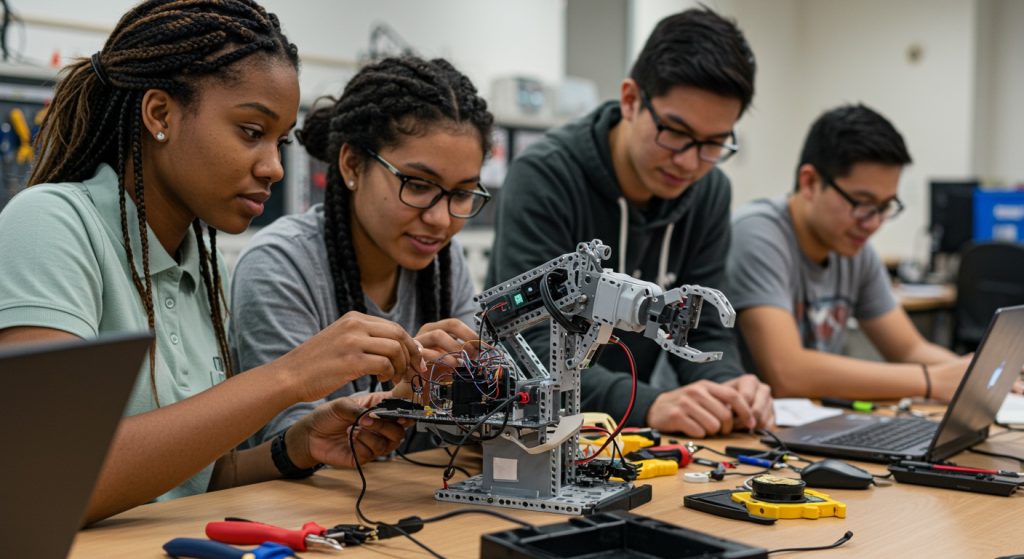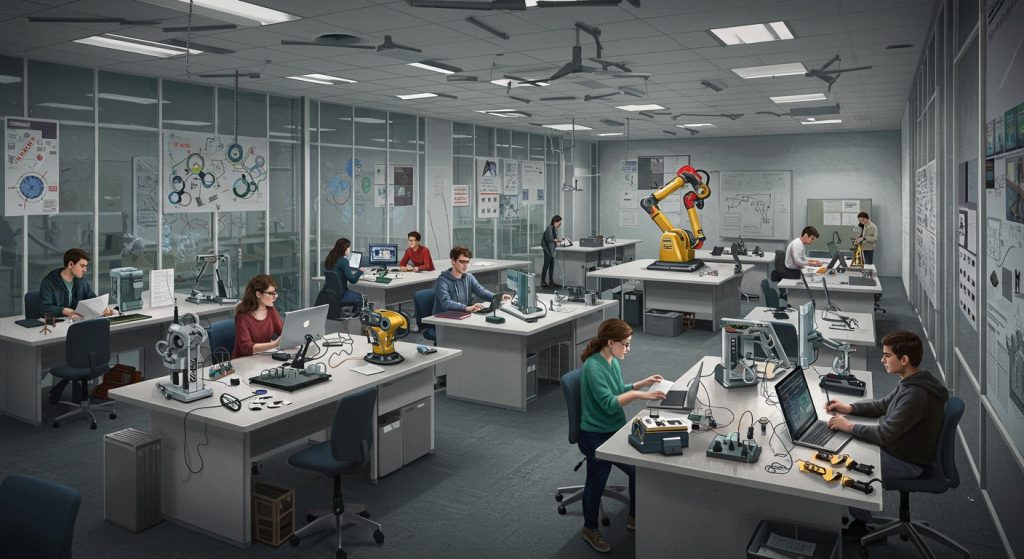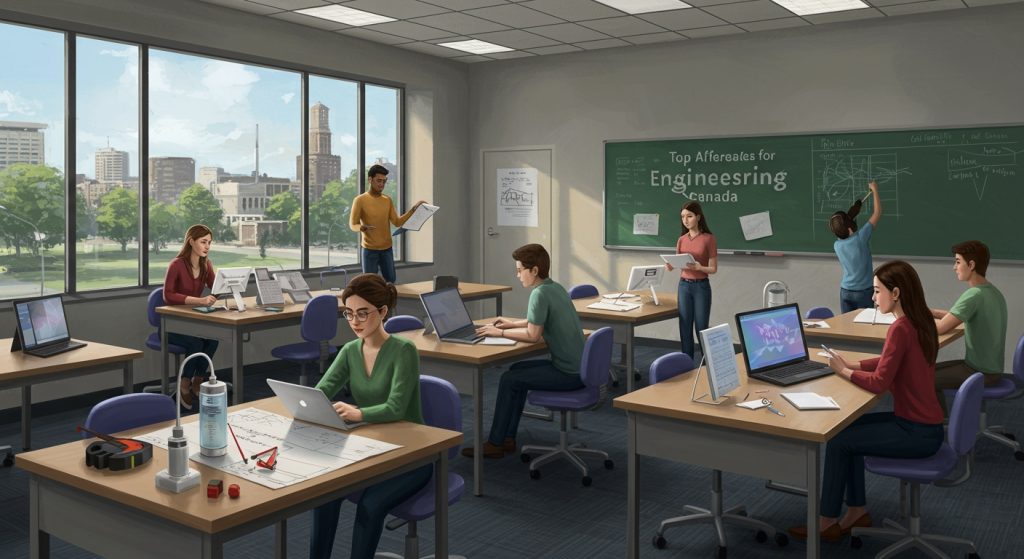Introduction
Imagine a bridge collapsing, not because of faulty materials. Because the engineers who designed it only ever saw blueprints on a screen. It’s a chilling thought, isn’t it? We’re living in an era where theoretical knowledge is readily available. The vital link to real-world application is often missing. For too long, engineering education has leaned heavily on lectures and simulations, leaving graduates unprepared for the messy, unpredictable nature of actual engineering challenges. That’s why we’re exploring a critical shift: engineering programs that prioritize hands-on experience, bridging the gap between theory and practice and building the next generation of problem-solvers ready to tackle anything. Get ready to discover programs that put the tools in your hands and the real world at your fingertips.
Beyond the Lecture Hall: Finding Engineering Programs That Build, Test. Iterate
Let’s face it, engineering isn’t just about crunching numbers and memorizing formulas. It’s about building things, solving real-world problems. Getting your hands dirty. That’s why choosing an engineering program that prioritizes hands-on experience is crucial for career success. We’re talking about programs that go beyond theoretical knowledge and immerse you in practical application, design. Teamwork. Think of it this way: a textbook can tell you how to build a bridge. Only hands-on experience will teach you how to troubleshoot when the wind shear calculations are off or how to manage a team when deadlines loom. These programs aren’t just about earning a degree; they’re about building a portfolio of projects and skills that will make you stand out to employers. The best engineering programs grasp this and actively integrate experiential learning into their curriculum. This can take many forms, from mandatory co-op programs and industry-sponsored projects to design-build competitions and undergraduate research opportunities. These experiences provide invaluable opportunities to apply classroom knowledge to real-world challenges, develop critical thinking skills. Build a professional network. For instance, a program with a strong co-op component allows you to alternate semesters of study with semesters of paid work experience in your field. This not only helps you finance your education but also gives you a significant advantage in the job market after graduation.
Decoding the Hands-On Curriculum: What to Look For
So, how do you identify these hands-on engineering programs? It’s not always explicitly stated in the program description, so you need to dig a little deeper. Start by looking at the curriculum. Does it include courses focused on design, prototyping, or manufacturing? Are there opportunities to participate in capstone projects that require you to design and build a complete system or product? Look for programs that emphasize project-based learning, where you’re constantly working on real-world problems in teams. Beyond the curriculum, consider the resources available to students. Does the university have well-equipped labs and workshops? Are there dedicated spaces for students to work on projects? Are there opportunities to work with faculty on research projects? A strong indicator of a hands-on program is the presence of student-run engineering clubs and organizations. These groups often organize competitions, workshops. Other activities that provide valuable hands-on experience. For example, a university with a strong robotics club likely provides ample opportunities for students to design, build. Program robots. Consider, too, the university’s relationship with industry. Are there partnerships with local companies that offer internships, sponsorships, or project collaborations? Universities for Computer Science with Industry Partnerships are a great example of this.
Building Your Future: Career Paths and Outcomes
The benefits of a hands-on engineering education extend far beyond the classroom. Graduates of these programs are highly sought after by employers because they possess the practical skills and experience needed to hit the ground running. They’re not just familiar with the theory; they’ve actually built things, solved problems. Worked in teams. This translates into a significant competitive advantage in the job market. Here are some of the key advantages of choosing a hands-on engineering program:
- Enhanced Problem-Solving Skills: You’ll learn to think critically and creatively to overcome real-world challenges.
- Improved Teamwork and Communication Skills: You’ll collaborate with peers on projects, learning to communicate effectively and work as part of a team.
- Increased Confidence and Self-Reliance: You’ll gain the confidence to tackle complex engineering problems and the self-reliance to work independently.
- Stronger Industry Connections: You’ll build relationships with industry professionals through internships, co-ops. Project collaborations.
- A More Impressive Portfolio: You’ll graduate with a portfolio of projects that showcases your skills and experience to potential employers.
Ultimately, choosing a hands-on engineering program is an investment in your future. It’s an opportunity to develop the skills, experience. Connections you need to succeed in a rapidly evolving industry. So, do your research, ask the right questions. Choose a program that will empower you to build, test. Iterate your way to a successful engineering career.
Conclusion
The journey through engineering programs offering hands-on experience reveals a clear path: practical application is paramount. We’ve seen how these programs bridge the gap between theory and real-world problem-solving, fostering innovation and critical thinking. As an expert in the field, I’ve observed that students who actively engage in projects and internships not only grasp concepts more deeply but also develop invaluable soft skills like teamwork and communication. A common pitfall, But, is focusing solely on technical skills while neglecting the importance of collaboration. Remember, engineering is rarely a solitary pursuit. My best advice? Seek out programs that emphasize interdisciplinary projects and offer opportunities to work alongside industry professionals. This exposure will provide a realistic preview of your future career and equip you with the tools to thrive. Embrace challenges, learn from your mistakes. Never stop exploring. Your dedication and passion will pave the way for a successful and fulfilling engineering career.
FAQs
So, what exactly does ‘hands-on experience’ in an engineering program even mean? Is it just building a toothpick bridge?
Haha, while toothpick bridges might be involved (depending on the program!) , it’s way more than that. ‘Hands-on’ means you’re actively applying what you learn in lectures to real-world projects, labs, simulations. Sometimes even internships. Think designing circuits, building robots, coding software, or testing materials – actually doing engineering, not just reading about it.
Why is hands-on experience so essential, anyway? Can’t I just learn everything from books?
You could try. Trust me, it’s not the same! Books give you the theory. Hands-on experience lets you see how that theory plays out in reality. You’ll learn problem-solving skills, how to work in a team. How to deal with the inevitable hiccups that happen when you’re building something. Plus, employers LOVE seeing hands-on experience on your resume – it shows you’re ready to hit the ground running.
What kind of programs typically offer the most hands-on learning?
Generally, programs that emphasize project-based learning, co-ops. Internships tend to be the most hands-on. Look for programs that specifically mention design projects, lab work, or industry partnerships. Some universities even have makerspaces or engineering clubs where you can tinker and build outside of class.
Okay. Are all hands-on experiences created equal? What should I look for to ensure it’s good hands-on experience?
That’s a great question! You want to look for experiences that are relevant to your field of interest, challenging enough to push you. Give you the opportunity to work with real tools and technologies. Also, consider the level of support you’ll receive from faculty and mentors. A good hands-on experience will have a strong support system in place.
How do I find out if a specific engineering program is really as hands-on as they claim to be?
Do your research! Check out the program’s website for details on lab facilities, project descriptions. Industry partnerships. Talk to current students or alumni – they’ll give you the inside scoop. And if possible, visit the campus and see the labs and workshops for yourself. Don’t be afraid to ask specific questions about the hands-on opportunities available.
Will choosing a program with lots of hands-on experience make my tuition more expensive?
It could. Not necessarily. Programs with extensive labs and equipment might have higher lab fees. The cost of tuition is usually determined by other factors as well. It’s worth comparing the overall cost of different programs, considering the value of the hands-on experience you’ll gain. Think of it as an investment in your future!
What if I’m not naturally ‘good’ at building things? Will I struggle in a hands-on program?
Don’t worry! Hands-on programs are designed to help you develop those skills. The point isn’t to be a master builder from day one. To learn and grow through experience. You’ll have opportunities to practice, make mistakes. Learn from them. Plus, you’ll be working with classmates who have different strengths, so you can support each other.



